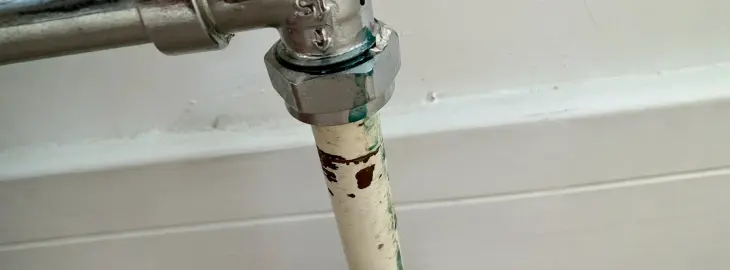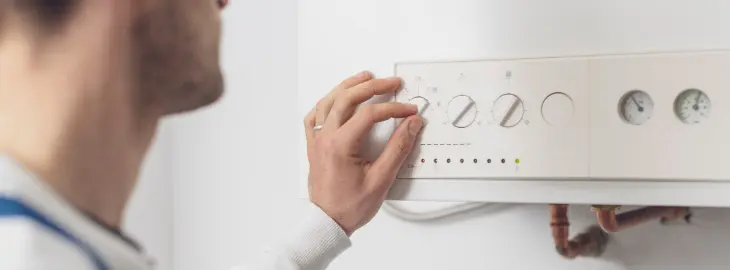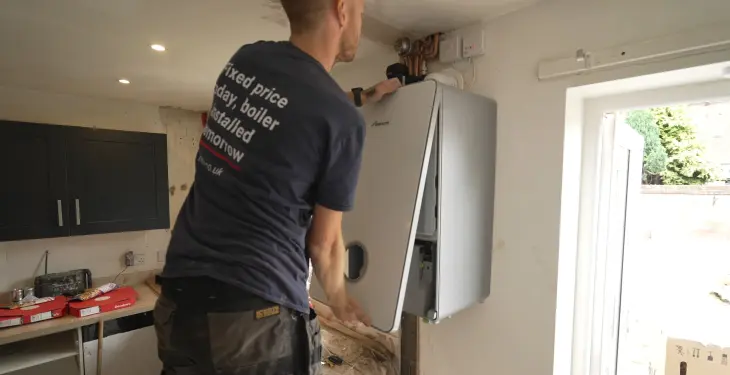

Written by Stephen Day
Gas Safe Engineer
Updated: 28th November, 2025
A leaking lockshield valve is usually caused by a loose gland nut, worn seal or corrosion, and can sometimes be tightened safely at home.
Get a new boiler quote, save up to £550 per year (0% APR available).
A lockshield valve controls how much hot water flows through a radiator. It helps balance the heating system so every room warms up evenly.
When this valve leaks, it usually affects the gland nut under the cap or the joint where the valve meets the pipework.
Even a small leak can create a damp patch below the radiator or cause your boiler pressure to drop slowly over time.
For example, a tiny weep around the gland nut may not drip straight away but can reduce system pressure across several days.
Understanding how the valve works helps you decide whether a simple tightening is safe or if the valve needs professional attention.
Several everyday issues can cause a leak around the valve.
These are the causes heating engineers see most often.
The gland nut keeps the internal seal compressed.
If it becomes loose or the seal ages, a small amount of water can escape.
Over time, the internal fibre washer or seal can dry out or split.
This often affects older heating systems or radiators that have not been serviced in many years.
If the radiator has been knocked, moved or bumped, it may disturb the valve and create a small gap.
Even slight movement in the pipework can cause a new leak.
Systems that have not had inhibitor added regularly can develop corrosion on valves and pipe joints.
This creates weak points where leaks form. A white or green crust on the valve is often a sign of corrosion.
Many leaks appear after radiators have been lifted off the wall for painting or wallpapering.
A seal may shift when the pipework is disturbed.
A leak is not always obvious at first. Look out for:

A wet carpet, skirting or towel on the floor usually means water is escaping slowly.

Wipe the area dry and check if new water forms. Even a small bead counts as a leak.

These are early signs of corrosion and often indicate a failing seal.

If pressure keeps dropping after topping up, water is escaping somewhere in the system. A leaking valve is a common cause.
If your pressure keeps falling, our guide on boiler losing pressure explains why it happens and what you can check safely.
These steps help you understand what is happening and prevent further issues.
Use a tissue or cloth to see if water is coming from the gland nut, the pipe joint or the valve body.
A reading near zero means water is escaping somewhere.
If the leak is small, pressure may drop over several days.
This makes it easier to see if fresh water appears.
If water only appears when the radiator warms up, the seal inside the valve may have worn.
Example: A homeowner may notice the towel rail is dry when the heating is off, but a small bead of water forms as soon as the system heats up.
This usually points to a fatigued seal.
These steps are safe for most homeowners and often resolve minor leaks.
If anything feels loose, damaged or corroded, stop and call an engineer.
Remove the small cap on the valve. Underneath is the gland nut. Gently tighten it using quarter turns only.
Over tightening can damage the valve, so small adjustments are enough.
After tightening, wipe the area dry and check again after ten minutes.
If water has stopped appearing, the issue was likely a loose gland nut.
If the leak appears where the pipe meets the valve, a gentle tightening may help. Only apply light pressure.
If the nut spins freely or the leak worsens, stop immediately.
A repair will not work if the valve body is cracked, the seal has collapsed or corrosion has weakened the joint.
In these cases, the valve needs replacing.
Symptom | Likely Cause | Safe Home Check | When to Call an Engineer |
|---|---|---|---|
Slow weep around gland nut | Loose seal | Gentle quarter turn | If leak returns |
Water at pipe joint | Old washer | Check nut tightness | If joint feels loose |
White or green residue | Corrosion | Wipe and observe | Immediate engineer check |
Pressure keeps dropping | System leak | Top up once | If pressure drops again |
Leak after decorating | Disturbed valve | Check gland nut | If water worsens |
If your radiator is cold at the top rather than leaking, our how to bleed a radiator guide explains how to release trapped air safely.
It is important to stop and get help when:
The leak increases after any adjustments
Boiler pressure drops again after topping up
You see corrosion around the valve or pipe
The valve feels loose or moves unexpectedly
You cannot find the exact source of the leak
Water is dripping steadily and not just weeping
If pressure drops within hours of topping up, there is likely a system leak that requires proper diagnosis.
Some valves can be tightened and continue working well.
Others need replacing. Replacement is normally required when:
The seal has completely worn out
The valve body is cracked
Corrosion has weakened the joint
The leak returns after tightening
The radiator or pipework has been disturbed several times
Homes that have not had inhibitor added regularly often show corrosion on older valves, which increases the likelihood of replacement.
A very small weep may allow you to use the heating for a short time, but you should monitor it closely.
If the leak is steady or pressure drops quickly, turn the system off and arrange a repair.
Never ignore a leak that worsens when the heating is on or one that causes repeated pressure loss.
The cost to fix a leaking radiator valve usually ranges from £80 to £150 depending on the issue and your location.
More complex repairs involving corrosion or damaged pipework may cost more.
This range is an average across the UK and is not specific to iHeat.
A leaking lockshield valve is usually caused by a worn seal, a loose gland nut or corrosion on older systems.
Small leaks can often be eased with gentle tightening, but any signs of corrosion, returning leaks or repeated pressure drops mean the valve needs professional attention.
iHeat installs new boilers through trusted Gas Safe engineers.
If your heating system is older or has issues with pressure or leaks, iHeat can advise on the next steps when upgrading your boiler.
Last updated: 28th November, 2025

Written by Stephen Day
Gas Safe Engineer at iHeat
Stephen Day is a Gas Safe registered and FGAS certified engineer with over 20 years of hands-on experience in the heating, cooling, and renewable energy industry, specialising in boiler installations, air conditioning, and heat pump systems.
LinkedInArticles by Stephen Day are reviewed by iHeat’s technical team to ensure accuracy and reliability.

22nd December, 2025
Based on data from over 7000 boiler installations completed by iHeat in the past 12 months...
 Read Article
Read Article

22nd December, 2025
Here’s a quick roundup of the best combi boilers for 2026.
 Read Article
Read Article

22nd December, 2025
When your old boiler breaks down and it comes time to replace it with a new one, it might...
 Read Article
Read Article
No obligation. Takes less than 60 seconds.